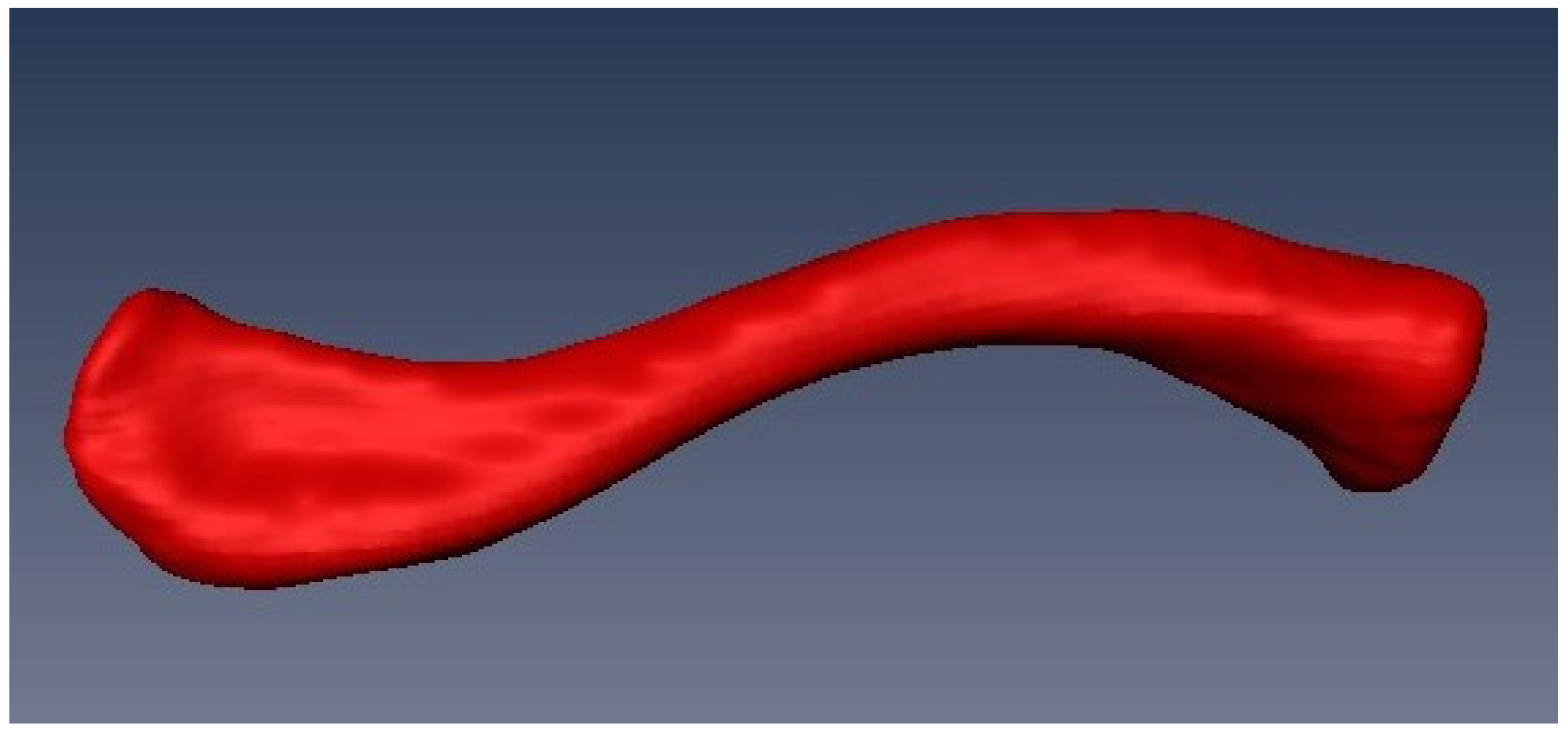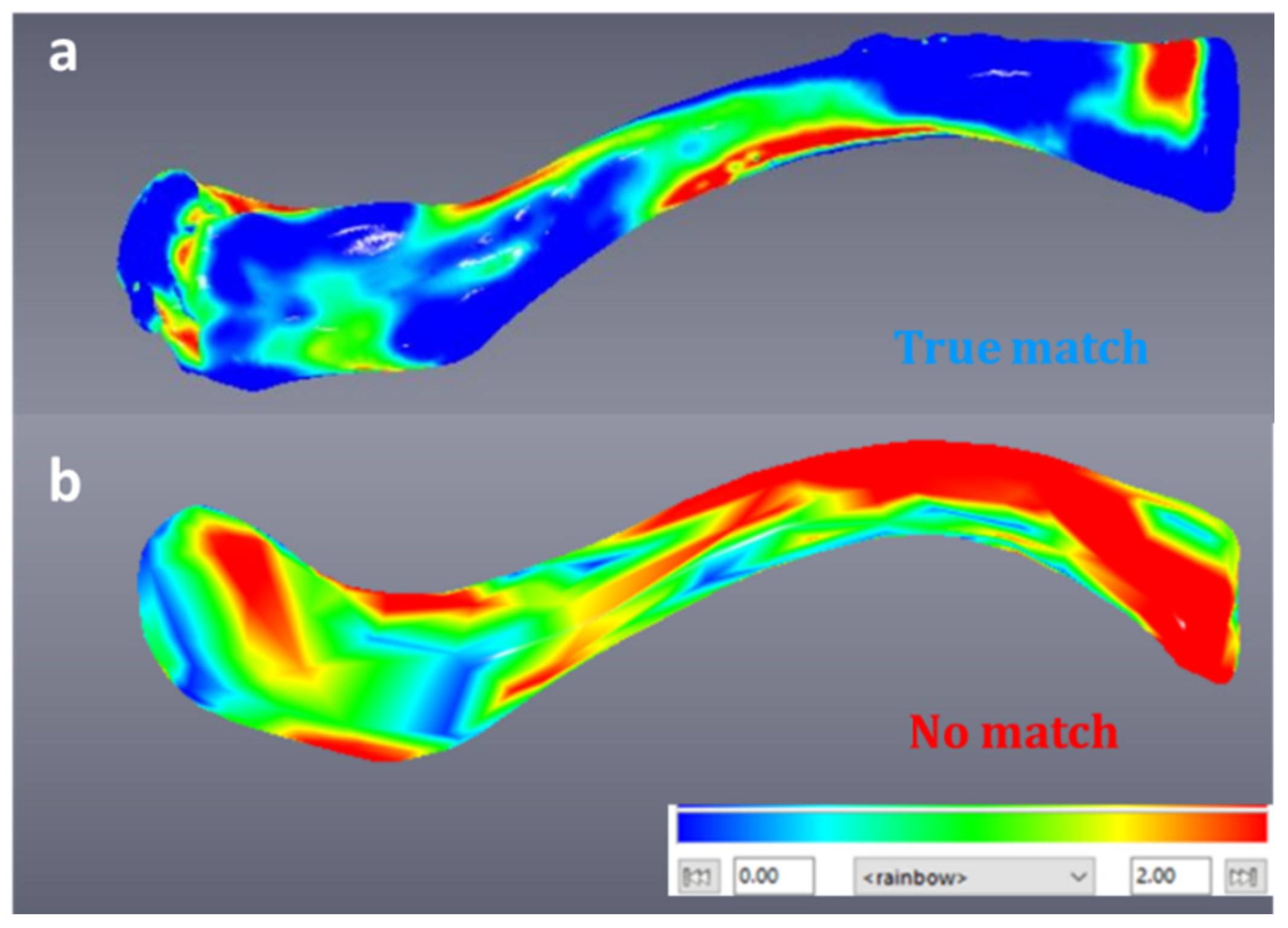Exploring the Functionality of Mesh-to-Mesh Value Comparison in Pair-Matching and Its Application to Fragmentary Remains
Abstract
:Simple Summary
Abstract
1. Introduction
2. Materials and Methods
2.1. Sample
2.2. Methods
2.2.1. Segmentation
2.2.2. Simulation of Fragments
2.2.3. Mirroring
2.2.4. Alignment
2.2.5. Hollowing
2.2.6. Mesh-to-Mesh Value Comparison Using Viewbox
2.3. Mesh Value Analysis
2.3.1. Lowest Common Value Comparison
2.3.2. Receiver Operating Characteristics (ROC)
3. Results
3.1. Lowest Common Value Comparison
3.1.1. Entire Clavicle Models
3.1.2. Simulated Fragment Models
3.2. ROC Analysis
3.2.1. Entire Clavicle Models
3.2.2. Simulated Fragment Models
4. Discussion
4.1. Comparisons with Other Studies and Methods
4.2. Analysis Method: LCV vs. ROC
4.3. The Effect of Age and Pathology
4.4. The Effect of Fragmentation
5. Conclusions
Author Contributions
Funding
Institutional Review Board Statement
Informed Consent Statement
Data Availability Statement
Conflicts of Interest
References
- Adams, B.J.; Byrd, J.E. Resolution of small-scale commingling: A case report from the Vietnam War. Forensic Sci. Int. 2006, 156, 63–69. [Google Scholar] [CrossRef] [PubMed]
- Osterholtz, A. Theoretical Approaches to Analysis and Interpretation of Commingled Human Remains, 1st ed.; Springer International Publishing: Berlin/Heidelberg, Germany, 2016. [Google Scholar]
- Lambacher, N.; Gerdau-Radonic, K.; Bonthorne, E.; de Tarazaga Montero, F.J.V. Evaluating three methods to estimate the number of individuals from a commingled context. J. Archaeol. Sci. Rep. 2016, 10, 674–683. [Google Scholar] [CrossRef] [Green Version]
- GarridoVaras, C.; Intriago Leiva, M. Managing Commingled Remains from Mass Graves: Considerations, Implications and Recommendations from a Human Rights Case in Chile; Forensic Science International; Elsevier Ireland Ltd.: Dublin, UK, 2012; Volume 219, pp. e19–e24. [Google Scholar]
- Wagner, S. Commingled Remains, Commingled Human Remains: Methods in Recovery, Analysis, and Identification; Elsevier: Amsterdam, The Netherlands, 2014. [Google Scholar]
- Ubelaker, D. Approaches to the study of commingling in human skeletal biology. In Advances in Forensic Taphonomy. Method, Theory and Archaeological Perspectives; Haglund, W., Sorg, M., Eds.; CRC Press: Boca Ratón, FL, USA, 2002. [Google Scholar]
- Byrd, J.E.; Legarde, C.B. Osteometric Sorting, Commingled Human Remains: Methods in Recovery, Analysis, and Identification; Elsevier: Amsterdam, The Netherlands, 2014. [Google Scholar]
- Robb, J.; Elster, E.S.; Isetti, E.; Knüsel, C.J.; Tafuri, M.A.; Traverso, A. Cleaning the dead: Neolithic ritual processing of human bone at Scaloria Cave, Italy. Antiquity 2015, 89, 39–54. [Google Scholar] [CrossRef] [Green Version]
- Holst, M.K.; Heinemeier, J.; Hertz, E.; Jensen, P.; Løvschal, M.; Mollerup, L.; Odgaard, B.V.; Olsen, J.; Søe, N.E.; Kristiansen, S. Direct evidence of a large Northern European Roman period martial event and postbattle corpse manipulation. Proc. Natl. Acad. Sci. USA 2018, 115, 5920–5925. [Google Scholar] [CrossRef] [Green Version]
- Konigsberg, L.W.; Adams, B.J. Estimating the Number of Individuals Remains: A Critical Evaluation of Methods, Commingled Human Remains: Methods in Recovery, Analysis, and Identification; Elsevier: Amsterdam, The Netherlands, 2014. [Google Scholar]
- Thomas, R.M.; Ubelaker, D.H.; Byrd, J.E. Tables for the Metric Evaluation of Pair-Matching of Human Skeletal Elements. J. Forensic Sci. 2013, 58, 952–956. [Google Scholar] [CrossRef] [PubMed]
- Byrd, J.E.; Adams, B.J. Osteometric sorting of commingled human remains. J. Forensic Sci. 2003, 48, 717–724. [Google Scholar] [CrossRef] [PubMed]
- Lynch, J.J.; Byrd, J.; LeGarde, C.B. The Power of Exclusion using Automated Osteometric Sorting: Pair-Matching. J. Forensic Sci. 2018, 63, 371–380. [Google Scholar] [CrossRef]
- Steele, J.; Mays, S. Handedness and directional asymmetry in the long bones of the human upper limb. Int. J. Osteoarchaeol. 1995, 5, 39–49. [Google Scholar] [CrossRef]
- Hines, D.Z.; Vennemeyer, M.; Amory, S.; Huel, R.L.; Hanson, I.; Katzmarzyk, C.; Parsons, T.J. For DNA Analysis in Commingled Cases, Commingled Human Remains: Methods in Recovery, Analysis, and Identification; Elsevier: Amsterdam, The Netherlands, 2014. [Google Scholar]
- Garrido-Varas, C.; Rathnasinghe, R.; Thompson, T.; Savriama, Y. A New Method to Pair-match Metacarpals Using Bilateral Asymmetry and Shape Analysis. J. Forensic Sci. 2014, 60, 118–123. [Google Scholar] [CrossRef]
- Bertsatos, A.; Chovalopoulou, M. Advances in Osteometric Sorting: Utilizing Diaphyseal CSG Properties for Lower Limb Skeletal Pair-Matching. J. Forensic Sci. 2020, 65, 1400–1405. [Google Scholar] [CrossRef] [PubMed]
- Fancourt, H.S.; Lynch, J.J.; Byrd, J.E.; Stephan, C.N. Next-generation osteometric sorting: Using 3D shape, elliptical Fourier analysis, and Hausdorff distance to optimize osteological pair-matching. J. Forensic Sci. 2021, 66, 821–836. [Google Scholar] [CrossRef] [PubMed]
- Karell, M.A.; Langstaff, H.K.; Halazonetis, D.; Minghetti, C.; Frelat, M.; Kranioti, E. A novel method for pair-matching using three-dimensional digital models of bone: Mesh-to-mesh value comparison. Int. J. Leg. Med. 2016, 130, 1315–1322. [Google Scholar] [CrossRef] [Green Version]
- Karell, M.A.; Lay, M.; Langstaff, H.K.; Kranioti, E.F. Pair-matching temporals using a digital mesh-to-mesh value comparison method. La Revue de Médecine Légale 2017, 8, 185. [Google Scholar] [CrossRef]
- Tsiminikaki, K.; Karell, M.A.; Nathena, D.; Halazonetis, D.; Spanakis, K.; Kranioti, E.F. Three-Dimensional Geometry of Phalanges as a Proxy for Pair-Matching: Mesh Comparison Using an ICP Algorithm. In Biomedical Visualisation. Advances in Experimental Medicine and Biology; Rea, P.M., Ed.; Springer: Cham, Switzerland, 2019; Volume 1205. [Google Scholar] [CrossRef]
- Herrmann, N.P.; Devlin, J.B.; Stanton, J.C. Assessment of Commingled Human Remains Using a GIS-Based and Osteological Landmark Approach, Commingled Human Remains: Methods in Recovery, Analysis, and Identification; Elsevier: Amsterdam, The Netherlands, 2014. [Google Scholar]
- Vickers, S.; Lubinski, P.M.; Henebry DeLeon, L.; Bowen, J.T., Jr. Proposed Method for Predicting Pair Matching of Skeletal Elements Allows Too Many False Rejections. J. Forensic Sci. 2015, 60, 102–106. [Google Scholar] [CrossRef] [PubMed]
- Ekizoglu, O.; Er, A.; Bozdağ, M.; Akcaoglu, M.; Can, I.O.; García-Donas, J.G.; Kranioti, E.F. Sex estimation of the tibia in modern Turkish: A computed tomography study. Leg. Med. 2016, 23, 89–94. [Google Scholar] [CrossRef] [PubMed] [Green Version]
- Lambert, S.; Al-Hadithy, N.; Sewell, M.D.; Hertel, R.; Südkamp, N.; Noser, H.; Kamer, L. Computerized tomography based 3D modeling of the clavicle. J. Orthop. Res. 2016, 34, 1216–1223. [Google Scholar] [CrossRef] [PubMed] [Green Version]
- Acuff, A.S.; Karell, M.A.; Spanakis, K.E.; Kranioti, E.F. Pair-Matching Digital 3D Models of Temporomandibular Fragments Using Mesh-To-Mesh Value Comparison and Implications for Commingled Human Remain Assemblages. In Biomedical Visualisation. Advances in Experimental Medicine and Biology; Rea, P.M., Ed.; Springer: Cham, Switzerland, 2021; Volume 1317. [Google Scholar] [CrossRef]
- Black, S.; Scheuer, L. Age Changes in the Clavicle: From the Early Neonatal Period to Skeletal Maturity. Int. J. Osteoarchaeol. 1996, 6, 425–434. [Google Scholar] [CrossRef]
- Chetverikov, D.; Svirko, D.; Stepanov, D.; Krsek, P. The Trimmed Iterative Closest Point algorithm. In Object Recognition Supported by User Interaction for Service Robots; IEEE: Manhattan, NY, USA, 2003; Volume 3, pp. 545–548. [Google Scholar]
- Ruopp, M.D.; Perkins, N.J.; Whitcomb, B.W.; Schisterman, E.F. Youden Index and optimal cut-point estimated from observations affected by a lower limit of detection. Bio. J. 2008, 50, 419–430. [Google Scholar] [CrossRef] [Green Version]
- Zweig, M.H.; Campbell, G. Receiver-operating characteristic (ROC) plots: A fundamental evaluation tool in clinical medicine. Clin. Chem. 1993, 39, 561–577. [Google Scholar] [CrossRef]
- Hanley, J.A.; McNeil, B.J. A method of comparing the areas under receiver operating characteristic curves derived from the same cases. Radiology 1983, 148, 839–843. [Google Scholar] [CrossRef] [Green Version]
- Sehrawat, J.S.; Pathak, R. Variability in anatomical features of human clavicle: Its forensic anthropological and clinical significance. Transl. Res. Anat. 2016, 3, 5–14. [Google Scholar] [CrossRef] [Green Version]
- Daruwalla, Z.J.; Courtis, P.; Fitzpatrick, C.; Fitzpatrick, D.; Mullett, H. Anatomic variation of the clavicle: A novel three-dimensional study. Clin. Anat. 2010, 23, 199–209. [Google Scholar] [CrossRef]
- Auerbach, B.M.; Raxter, M.H. Patterns of clavicular bilateral asymmetry in relation to the humerus: Variation among humans. J. Hum. Evol. 2008, 54, 663–674. [Google Scholar] [CrossRef]
- Ekizoglu, O.; Hocaoglu, E.; Inci, E.; Can, I.O.; Aksoy, S.; Sayin, I. Estimation of forensic age using substages of ossification of the medial clavicle in living individuals. Int. J. Leg. Med. 2015, 129, 1259–1264. [Google Scholar] [CrossRef] [PubMed]
- Loh, J.L.; Wong, K.L.; Hwang, S.; Shen, L.; Murphy, D.P.; Daruwalla, Z.J. Orthopedic asymmetry and clavicle length. Clin. Anat. 2015, 28, 964. [Google Scholar] [CrossRef]
- Mohsin, A.; Alam, Z.; Faruqi, N.A. Bilateral variations in the growth and development of human foetal clavicle. Biomed. Res. (India) 2013, 24, 235–241. [Google Scholar]
- Mahfouz, M.R.; Mustafa, A.; Fatah, E.E.A.; Herrmann, N.; Langley, N.R. Computerized reconstruction of fragmentary skeletal remains. Forensic Sci. Int. 2017, 275, 212–223. [Google Scholar] [CrossRef] [PubMed]




| Sex | Number (Total) | Healed Fractures | Under 28 Years |
|---|---|---|---|
| Male | 54 | 4 | 6 |
| Female | 106 | 5 | 10 |
| Total | 160 | 9 | 16 |
| LCV | ROC | |||
|---|---|---|---|---|
| Sensitivity | Specificity | Sensitivity | Specificity | |
| 160 clavicles | 88.8% | 42.5% | 87.6% | 90.9% |
| 151 clavicles (Pathological specimens excluded) | 82.8% | 26.1% | 89.5% | 90.1% |
| 144 clavicles (Under age 28 excluded) | 81.8% | 0% | 87.6% | 90.98% |
| 160 acromial fragments | 54% | 40% | 87.6% | 87.9% |
| 160 midshaft fragments | 31.3% | 37.8% | 81.3% | 74.8% |
| 160 sternal fragments | 65.4% | 52.6% | 83.8% | 83.5% |
| Sample | Author | Sensitivity | Specificity |
|---|---|---|---|
| 45 mixed ancestry humeri (24 individuals) | Karell et al., 2016 | 95% | 60% |
| 120 Modern Greek temporals (60 individuals) | Karell et al., 2017 | 98% | 100% |
| 70 Cretan mandibular condyles (35 individuals) | Acuff et al., 2021 | 88.58% | 0% |
| 69 Cretan mandibular fossae (35 individuals) | Acuff et al., 2021 | 91.17% | 100% |
| 160 Modern Turkish clavicles (80 individuals) | This study | 88.8% | 42.5% |
| 160 acromial fragments (80 individuals) | This study | 54% | 40% |
| 160 midshaft fragments (80 individuals) | This study | 31.3% | 37.3% |
| 160 sternal fragments (80 individuals) | This study | 65.4% | 52.6% |
| Fragment Type | LCV Sensitivity | LCV Specificity | ROC Sensitivity | ROC Specificity |
|---|---|---|---|---|
| Sternal | 55.4% | 56.5% | 83.8% | 83.5% |
| Midshaft | 40.5% | 37.8% | 81.3% | 74.8% |
| Acromial | 65.7% | 40% | 87.5% | 87.9% |
| Entire clavicles | 88.8% | 42.5% | 87.6% | 91.1% |
Publisher’s Note: MDPI stays neutral with regard to jurisdictional claims in published maps and institutional affiliations. |
© 2021 by the authors. Licensee MDPI, Basel, Switzerland. This article is an open access article distributed under the terms and conditions of the Creative Commons Attribution (CC BY) license (https://creativecommons.org/licenses/by/4.0/).
Share and Cite
McWhirter, Z.; Karell, M.A.; Er, A.; Bozdag, M.; Ekizoglu, O.; Kranioti, E.F. Exploring the Functionality of Mesh-to-Mesh Value Comparison in Pair-Matching and Its Application to Fragmentary Remains. Biology 2021, 10, 1303. https://doi.org/10.3390/biology10121303
McWhirter Z, Karell MA, Er A, Bozdag M, Ekizoglu O, Kranioti EF. Exploring the Functionality of Mesh-to-Mesh Value Comparison in Pair-Matching and Its Application to Fragmentary Remains. Biology. 2021; 10(12):1303. https://doi.org/10.3390/biology10121303
Chicago/Turabian StyleMcWhirter, Zoe, Mara A. Karell, Ali Er, Mustafa Bozdag, Oguzhan Ekizoglu, and Elena F. Kranioti. 2021. "Exploring the Functionality of Mesh-to-Mesh Value Comparison in Pair-Matching and Its Application to Fragmentary Remains" Biology 10, no. 12: 1303. https://doi.org/10.3390/biology10121303
APA StyleMcWhirter, Z., Karell, M. A., Er, A., Bozdag, M., Ekizoglu, O., & Kranioti, E. F. (2021). Exploring the Functionality of Mesh-to-Mesh Value Comparison in Pair-Matching and Its Application to Fragmentary Remains. Biology, 10(12), 1303. https://doi.org/10.3390/biology10121303






